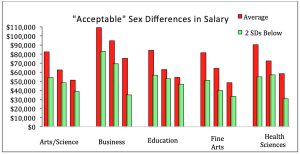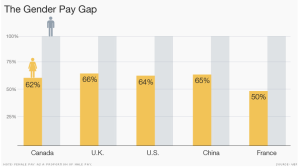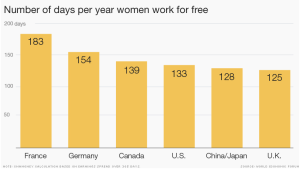Women, and what they are being paid for their work, is now on the political agenda. Both of the presidential candidates on the Democratic side, Hilary Clinton and Bernie Sanders, have discussed the issue of women’s pay as a part of their individual platforms. As the election season is heating up, the gender pay gap is not going anywhere and the media will only continue to dig deeper into the issue.
We wanted to look at how the pay gap is impacting education, specifically at WCU. This is an issue that has been explored previously by Laura Wright, an associate professor and head of the English Department at WCU. Provost Alison Morrison-Shetler also discusses the topic in a Q & A with WCJ . Looking at the statistics, we also find that research and history show that it is not just gap in salary – but also in paid leave opportunities such as maternity or access to benefits .
What is the gender pay gap?
The gender pay gap is the difference in salary between men and women who do the same job, where statistically, men are paid more than women. Although the pay gap has been an issue since women entered the work force, recent studies and protests have brought this issue into the public eye.
WCU conducted a gender equity study that was completed in 2014. Wright wrote a commentary for the faculty forum to discuss the results of this study.
The study showed that female faculty members earn $2,234 less than male faculty members, a number that amounts to a $67,020 difference over the course of 30 years, according to Wright.
The study concluded that, since none of the WCU faculty members’ salaries were two standard deviations or more from the mean salary within any specific group, WCU was in compliance with the Department of Labor guidelines.
Wright noted that, although WCU’s gender equity may be in compliance legally, but that doesn’t mean it’s fair and it doesn’t mean that gender inequity doesn’t exist at WCU.
“I hope that our university will follow the lead of other universities and organizations and make adjustments,” said Betty Farmer, a communication professor at WCU.
Hal Herzog, a psychology professor at WCU, also contributed to the faculty commentary. His graph broke down the “Acceptable” Sex Differences in Salary according to the legal definition. He concluded that, at WCU, a male assistant professor in the College of Business could make $77,353 a year, while his female counterpart made only $36,000 a year, and WCU would still be in compliance legally because those figures are not two standard deviations or more apart from one another.

Herzog’s graph illustrates the differences in salary between departments at WCU.
Unfortunately, the gender pay gap only seems to get worse with education. The biggest pay gaps are occurring in people with advanced degrees. In a summary paper from the White House Council of Economic Advisers from 2015, on average, women with a professional degree are paid 67 cents to their male counterpart’s dollar, which is approximately 10 cents less than the national average. This gap, according to this paper is better than it was in 1970 or 1990, but things have not changed much since 2001. At the same time, women are discriminated against in getting a paid leave and access to benefits.
At WCU, male full professors earn $25,363 more than their female counterparts according to Wright.
To be fair, WCU’s gender pay gap is smaller than many other places, with women earning 87 cents for every dollar earned by men compared to the national average of 78 cents to the dollar. The national average has fluctuated between 76 and 78 cents to the dollar since 2001, but it has not narrowed significantly since the 1990s.
Why is this a problem?
Society has been slowly addressing the issue of equal pay for several years now. Unfortunately, the progress has not been substantial. According to CNN Money, there is no country in the world where a man and women who do the same job receive equal pay. Additionally, the U.S. ranks 74th out of 145 countries in wage equality which is worse that in 2014 when USA pay gap was at 66%. CNN is getting this information from the World Economic Forum Gender Gap Report for 2015.
A breakdown of the pay gap in North Carolina can be found in an excel document here and in the United States here. This data was compiled from the American Association of University Women‘s publications ‘The Simple Truth about the Gender Pay Gap‘ and ‘The Fight for Pay Equity: A Federal Road Map‘.

A CNN article discusses the difference in pay in five countries.
Today, women make up 47 percent of the labor force, hold 49.3 percent of jobs and hold the majority of all undergraduate and graduate degrees. College graduates earn more than twice what high school graduates would, according to a study conducted by the White House.
The White House study from 2015 calls the gender pay gap “unexplained”, pointing out that women have become the most skilled workers in the workforce. The Council of Economic Advisers deduced that two-thirds of the pay gap cannot be explained by “potential experience, age, race, education, industry or occupation.”
Resume studies were conducted and determined that two identical resumes, where only the names of opposite genders are different, would most often result in the male candidate being hired over the female candidate. Additionally, the starting salary for male candidates was greater and the employer’s opinion of the candidate’s quality was higher for the male – even though the resumes were identical!
According to a CNN article on the current status of the U.S. gender pay gap, the issue of equal pay will not be resolved until the year 2133, which is 117 years from now. This means that for women in their 20s, who are just now entering the workforce, neither they nor their daughters are likely to see equal pay in their lifetimes.
Additionally, the article noted that women today are earning what men were earning a decade ago.

A graph from the CNN article breaks down the number of days women work for free each year in six countries.
Various activist groups and organizations have attempted to draw attention to the issue through education, public policy negotiations and even protests.
April 14 is designated as Equal Pay Day to demonstrate how far into the new year average American women need to work, in addition to their work the previous year, in order to earn what the average American male did last year alone.
Some individuals and publications have attempted to persuade the public that the gender pay gap is actually a myth, citing reasons such as childbirth, career choice and the decision to work less hours as the reason behind the gap.
“I don’t know that people really are aware of the differences in pay,” said Farmer. “A lot of students in my classes express surprise when they learn that women, on average, make 77 cents to every dollar that a man earns. So, there needs to be greater awareness about this issue.”
How do we fix it?
So why, if women are gaining the most college degrees and becoming the most skilled workers, are men still making more than women?
One solution that the White House Economic advisers suggest is that women should seek higher paying jobs in order to ‘counter balance’ the pay gap in some way. Professions in the fields of science, technology, engineering and math (STEM) are the highest paying jobs and these fields also attract the least number of women. Women received 57 percent of all bachelor degrees in 2013, but only 35 percent of them were in STEM fields.
Women who enter these fields and then decide to choose a new career path often reference a hostile and masculine culture as the main reason. Specifically in this study from 2007 that looked at women with degrees in science, engineering and technology, 63 percent left the field because of sexual harassment by their male coworkers. Because there are so few women working in STEM fields, those who do often find themselves isolated from their male counterparts, making it difficult to build a support system and advance their career paths.
A difference in communication styles for men and women may also have an impact when it comes to negotiating salaries.
Research shows that women are statistically less likely to negotiate their salaries upon being hired than men are for the same position. When women do negotiate their salaries, many of them are penalized for doing so. An article from The Huffington Post by Joan Williams addresses the issue of salary negotiation for women and offers some solutions.
In her article, Williams said, “it’s complicated. If women act too feminine and don’t ask [for a raise], they end up with lower salaries. If they act too masculine and ask, then people don’t want to work with them. Women walk a tightrope between being too feminine and too masculine. Men don’t.”
Because women are often unable to or hesitant about negotiating their salary, they end up receiving even less money than men, who are far more likely to request a specific salary when being hired.
Fortunately, the gender pay gap has received some attention from the government in recent years.
President Obama’s first piece of legislation that he signed into law was the Lilly Ledbetter Act, which gives workers an extended time period to file a claim to recover wages lost due to discrimination.



